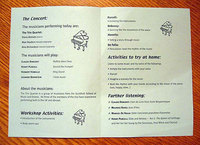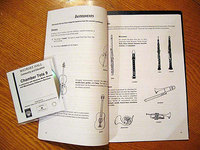English
Wigmore Hall Chamber Tots
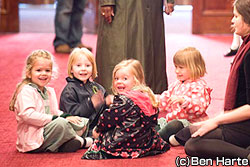
One of the most popular educational programmes at Wigmore Hall is 'Chamber Tots', a musical programme for toddlers from 2 to 5 years old. All 15 events sell out every year. Let us take a look at this flagship project!
title : Chamber Tots
Venue : Wigmore Hall - Main Hall, Bechstein Room
Fee: £6 a child
Time : 10:00-11:00(2-3 years old)/ 11:30-12:30(3-5 years old)
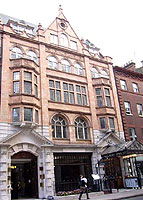
A family going to the Wigmore Hall
Launched in 1998, 'Chamber Tots' has become one of the most popular series of Wigmore Hall Learning. It was started to fill the gap between professional musicians and younger children, as well as to broaden the audience, most of whom are currently over 50, to include younger generation. Research has shown that the impact of musical activities on the targeted age group, 2 to 5 year-olds, is hugely important to foster their ability in terms of reception, concentration, respect for others, confidence and so on. 'Chamber Tots' aims to provide children of this age group the opportunity to listen to live music, learn about musical instruments and participate in a range of creative musical activities.
Julia Roderick, producer of Learning Department, explains, 'When talking about listening to live music, normal evening concerts are too formal and too long for the toddlers to sit still through and enjoy, so we devise short taster sessions for this age group, adding more interactive aspects.'
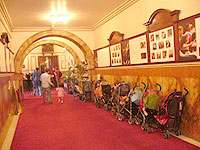
Many pushchairs at the entrance
'Chamber Tots' on this day was divided into two sessions: 2-3 year-olds and 3-5 year-olds. Fathers and mothers carrying their children came to the magnificent Wigmore Hall and, in no time, the entrance hall was full of pushchairs. When they registered, they were offered a programme for the day, and a cushion to make the seat high enough for small children to see the stage. The capacity for each event was 35. Although there were more people who wanted to attend, and there was enough room for a larger audience in the hall, it was necessary to keep the audience small in order to foster effective interactivity.
The first half of the event was a mini concert in the main hall. Two singers and a pianist appeared on stage. After introducing the first song by saying 'The first song is a duet. In that song, we will try to imitate certain kinds of musical instrument; that is, the trumpet and the oboe. Please listen carefully to how they sound', they sang a song called 'Sound the trumpet' by Purcell. The children gazed at the singers open-mouthed, as they were listening to very different voices from the spoken voices that they had just heard.
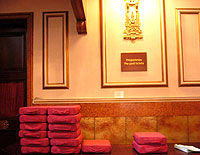
Extra cushions for the seats
The next instrument was the piano. 'If you cover your mouth with your hand and say something, you will hear a muffled voice. If you take your hand away, you will hear it more clearly. When I open the piano lid wide, you will hear the sound more clearly', said Diana, the pianist, and played 'Reflets dans l'eau' by Debussy, showing a great contrast between its quiet parts and its more vibrant parts. Then Juliet, the singer, came forward and talked: 'What do I do when my baby does not want to sleep, and keeps crying? Well, I sing a lullaby', and she sang a short lullaby softly. She took advantage of being a singer, looking into the children's eyes, and used her body and face to create atmosphere and attract their attention.
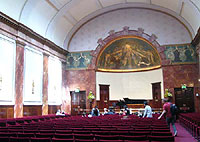
Inside the Hall
The fourth piece of music was 'King David'. While the musicians told the story and played the music, some children could not concentrate on the slow music and started to talk to their mothers or wander about. It seemed to be time to move on. 'OK, let's sing and play some music together! Meet us downstairs in 5 minutes!' said Nina, the singer, and closed the first half. The 15 minute session, including the talks, was quite a short concert, but long enough for the toddlers.
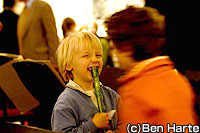
Wigmore Hall has a main hall and a multipurpose room on the lower ground floor called the 'Bechstein Room', which is used for most of the educational events, such as the talks and workshops. 'Chamber Tots' consisted of two parts; the 15 minute mini concert in the main hall in the first half, and a 15 to 20 minute workshop in the Bechstein Room in the latter half. This style has not changed basically since the outset. While the basic concept of providing children with activities which involve singing, moving and joining in interactively, the detailed programme, such as what piece to play and what activities to do, is left to the artists to decide.
The workshop leader who is in charge of 'Chamber Tots' is Natasha, who was also one of the workshop leaders of Guildhall Connect. 'Chamber Tots' collaborates with the Guildhall School of Music and Drama, and is supplied with a workshop leader and student artists. Students get credit for their practical learning. Here, they appear on stage 3 times under the mentorship of Natasha. The first time, Natasha is the main leader; the second time, more students' ideas are used; and, the last time, the students lead the group with Natasha in a supporting role. The leadership shifts from Natasha to the students gradually.
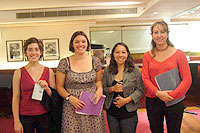
(from left) Julia, Nina, Natasha, Diana
This was the third day for this student ensemble. Natasha sat to one side keeping her eye on the event. The children came to the Bechstein Room and sat in a circle. Nina asked the children, 'Do you remember what instrument Diana played in the hall?' 'The piano!', the children answered. 'Right. Do you see any piano in this room? Yes, but is it different from the one in the hall?' she continued. 'It was bigger than this!' 'This is square,' they said.
Diana played many kinds of sounds on the piano: 'I can play very, very high...and very low. I can play softly, and bad and scary! I can play a melody with one finger, and I can play several notes at a time with some of my fingers. Can singers do that?' Nina replied to this, 'We singers cannot do that, actually. That is because we use what instead of the piano?' Then children replied, 'Mouth!' 'Yes, everyone has a mouth. So, everyone can sing! Open your mouth and show it to me! Big breath, and let me hear your voice!' 'AH---!' Then, the artists and the toddlers made short and sharp sounds, long sounds, high and low sounds, imitated laughing and a big bear sound.
'We were imitating the sound of musical instruments like this. Have you seen the trumpet?' Nina said, showing the children a picture of a trumpet. She asked, 'Do you know how to play it?' Some children put their hands up in front of their face. When the musicians made a gesture of playing the trumpet, the children followed it, shouting 'Brrr!' Then Nina and Juliet showed how it was used in the song that they sang.
While the pianist played 'Reflets dans l'eau', the children stood up and expressed the movement of the water through their gestures. They moved, imagining a flowing wave, jumping fish, and a heavy storm. The next song was 'King David'. The artists started to tell the story of King David, who was very sad, and listened to the music of the harp and birds singing, to ease his sorrow.
As soon as they started to tell the story, some of the children could not sit still and began to become restless, one by one. Sensing the state of the children, Natasha threw them a lifeline, 'Why don't you stand up and we can tell the story together?' Following Natasha, the children started to shake their heads, saying 'I'm sad...' They imitated playing a harp, walking in the dark wood, and singing like a bird. Once they began moving, they concentrated on what Natasha was doing and the changing mood of the music. At the end of the workshop, they sang some lullabies that they knew well, like 'Twinkle Twinkle Little Star', and played some percussion instruments of their choice, such as bells, drums, maracas and guiros, changing the way in which they played according to the music that the piano played; loud, soft, short or jumping.
As 'Chamber Tots' gained overwhelming support, the demand for the project from the people living in the area far from the hall, and from nurseries increased. It led to the development of an outreach project, 'Chamber Tots in the Community', which was launched in 2000. Since then, this event has taken place at 51 early years' settings in 11 boroughs in London, reaching more than 1000 children over 9 years. In addition to that, 5 nurseries and children's centres in the City of Westminster and 4 in Hackney hosted the event in 2009. These settings were not chosen at random but carefully selected in consultation with their partners, such as Westminster City Council and Hackney Music Services.
During each outreach project, 8 music workshops take place over 6 months. In 2009, 4 workshop leaders with over 20 years of experience and 3 ensembles covered 9 early years' settings. The artists visit the venue, a nursery for example, for 2 hours during the day. The first 45 minutes is allocated to circle time led by a leader, during which the children sing, play percussion instruments, listen to live music, take part in musical stories, and learn the concepts of high and low, loud and soft, and quick and slow.
The latter half is allocated to free play. They go back to the normal nursery format, and the artists help their activities from the musical aspect; the children lead the musical playing, experience playing many musical instruments, make their own musical instruments, and, if they want to play outside, they can do so. At the end of the project, the children gather at Wigmore Hall and perform the songs and music that they have learnt during the workshops in front of their families.
According to Julia, unlike one-off events at the hall, the development of children via 'Chamber Tots in the Community' is remarkable, because they have learnt music in the settings that they belong, and the children and artists have got to know each other very well over a 6 month period. In addition to the workshops for the children, the nursery receives 3 sessions of staff training, at the beginning, in the middle, and at the end. In many nurseries, musical education makes little headway because of the lack of skills, materials and confidence to practise efficient musical education. In order for the staff to have confidence and carry on the musical activities on their own after the 6 months, Wigmore Hall Learning offers staff training, encouraging the nursery staff to take part in the workshops, puts the musical workshop in normal nursery situations, provides them with resource packs which contain a lot of examples of musical activities that can be used in daily nursery activities, and explains their effects.
'Chamber Tots in the Community' requires a lot of effort for each setting but, once the ideas and skills of effective musical activities for toddlers has spread among the practitioners of early years education, more and more children receive efficient musical education on a daily basis and, as a result, it will cause a big change. 'Chamber Tots at Wigmore Hall' offers opportunities for young children who do not have access to the hall usually, and who do not know whether they like music or what they can do, to visit the hall and give it a try with their parents, on a casual basis. It may lead them to change their relationship with music in a positive way. Sustainability and the broad possibility of application are crucial for this kind of programme in order to build a long-term relationship between the children and music, and root music more deeply in the children's lives and in the wider community.
Report: Chigusa Futako


